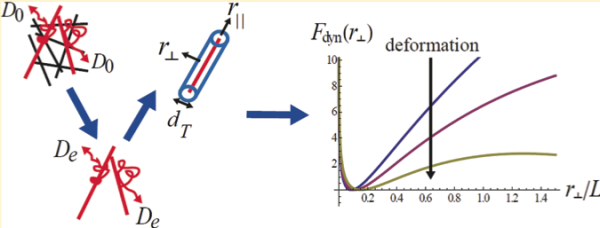Rheology of rods
Entangled polymers
 One of the main features of our theory of entanglement that qualitatively deviates from the Doi-Edwards tube model is our prediction of a anharmonically softened confinement tube. This seemingly innocuous statement, while physically reasonable (entanglements are, after all, not infinitely strong chemical crosslinks), has profound implications for how entangled polymers respond to applied fields and external deformations. In particular, reptation is no longer the only relaxation channel for the individual polymers; the finite strength of the lateral confinement field allows for transverse hopping motions, in analogy with yielding events in colloidal gels or glasses.
One of the main features of our theory of entanglement that qualitatively deviates from the Doi-Edwards tube model is our prediction of a anharmonically softened confinement tube. This seemingly innocuous statement, while physically reasonable (entanglements are, after all, not infinitely strong chemical crosslinks), has profound implications for how entangled polymers respond to applied fields and external deformations. In particular, reptation is no longer the only relaxation channel for the individual polymers; the finite strength of the lateral confinement field allows for transverse hopping motions, in analogy with yielding events in colloidal gels or glasses.
To explore the simplest of the rheological consequence, we embedded our microscopic model for the transverse confinement in a standard phenomenological description for instantaneous and continuous shear deformations of entangled rigid rods. Among other things, we found that convective-constraint-release physics (an ad hoc elaboration to the usual Doi-Edwards model that is needed to cure the theory of unphysical shear thinning at high deformation rates) emerges naturally from an anharmonic tube, without needing to insert additional physics by hand.